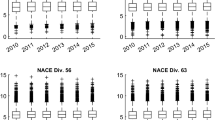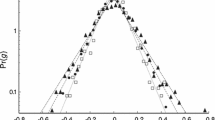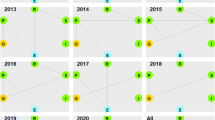Abstract
A “catastrophe theory” model of small firm growth allows for an abrupt change in small firm size. The model permits only smooth changes in the endogenous independent variables, turnover and profitability, yet allows sudden changes in the level of assets, the size variable. But not all growth paths suggested by the mathematics are likely to be met in the real world. Nevertheless, there are feasible phases of steady growth as well as feasible phases during which “jumps” occur.
Similar content being viewed by others
References
Acs, Zoltan J. and David B. Audretsch, 1987, ‘An Empirical Examination of Small Firm Growth’, Economic Letters 25(4), 363–366.
Acs, Zoltan J. and David B. Audretsch, 1989, ‘Births and Firm Size’, Southern Economic Journal 56(2), 467–475.
Aislabie, Colin, 1984, ‘On Modelling the Small Firm Growth Process’, in W. C. Dunlop and B. L. J. Gordon (eds.), Small Business Research: Proceedings of the Second National Conference, Newcastle: Institute of Industrial Economics, University of Newcastle, 129–142.
Aislabie, Colin, 1987, ‘The Entrepreneur and Small Firm Growth’, in C. A. Tisdell (ed.), Contributed Economic Essays: A Collection in Memory of Dr M. G. Kibria, Newcastle: Department of Economics, University of Newcastle, 157–175 (also published in Research Reports or Occasional Papers, Department of Economics, University of Newcastle, 144).
Aislabie, Colin, 1990, ‘The Implications for Survival in Small Firm Failure Studies’, in K. M. Renfrew and C. McCosker (eds.), The Growing Small Business: Proceedings of the Fifth National Conference, Newcastle: Institute of Industrial Economics, University of Newcastle, 301–315.
Australian Financing System, 1981, Financial Report of the Comminttee of Enquiry (Campbell Committee), Canberra: Australian Government Publishing Service.
Berryman, Joyce, 1983, ‘Small Business Bankrupcy and Failure: A Survey of the Literature’, European Small Business Journal 1(4), 47–59.
Binks, Martin, 1979, ‘Finance for Expansion in the Small Firm’, Lloyds Bank Review 134, 33–45.
Binks, Martin, 1980, ‘Expansion in the Small Firm: Some Problems of Finance’, Planned Innovation 3, 27–31.
Boardman, Calvin M., Jon W. Bartley, and Richard Ratliff, 1981, ‘Small Business Growth Characteristics’, American Journal of Small Business 5(3), 33–43.
Brown, William S., 1979, ‘A Discontinuous Macro Model’, Atlantic Economic Journal 7(2), 26–32.
Burghes, D. N. and A. D. Wood, 1984, Mathematical Models in the Social, Management and Life Sciences, Chichester: Ellis Horwood.
Casson, Mark, 1982, The Enterpreneur: An Economic Theory, Oxford: Martin Robertson.
Chidley, J., P. Lewis, and P. Walker, 1978, ‘The Cusp Catastrophe as a Market Planning Aid’, Behavioral Science 23, 351–384.
Churchill, Neil C. and Virginia L. Lewis, 1983, ‘The Five Stages of Small Firm Growth’, Harvard Business Review 63(3), 30–50.
Committee to Review the Functioning of Financial Institutions, 1980, Appendices, Cmnd 7939 (Wilson Committee), London: HMSO.
Cragg, Paul B. and Malcolm King, 1988, ‘Organizational Characteristics and Small Firms' Performance Revisited’, Entrepreneurship Theory and Practice 13(2), 49–64.
Elliott, J. W., 1973, Economic Analysis for Management Decisions, Homewood, Ill: Irwin.
George, D., 1981, ‘Equilibrium and Catastrophes in Economics’, Scottish Journal of Political Economy 28(1), 43–61.
Harris, L., 1979, ‘Catastrophe Theory, Utility Theory and Animal Spirits Expectations’, Australian Economic Papers 18(33), 268–282.
Isnard, C. A. and E. C. Zeeman, 1976, ‘Some Models from Catastrophe Theory in the Social Sciences’, in Lyndhurst Collins (ed.), The Uses of Models in the Social Sciences, London: Tavistock Publications, 44–100.
Marris, Robin, 1963, ‘A Model of the “Managerial” Enterprise’, Quarterly Journal of Economics 57(2), 185–209.
Marris, Robin, 1964, The Economic Theory of Managerial Capitalism, London: Macmillan.
Penrose, Edith T., 1952, ‘Biological Analogies in the Theory of the Firm’, American Economic Review 42(5), 804–819.
Perry, Chad, 1982, ‘Stage Theories of Small Business Growth’, Management Forum 8(4), 190–203.
Perry, Chad, 1983, ‘The Small Business Finance Gap: Now You See It, Now You Don't’, Management Forum 9(2), 52–62.
Peterson, Rein and J. Shulman, 1987, ‘Capital Structure of Growing Small Firms: A 12-Country Study on Becoming Bankable’, International Small Business Journal 5(4), 10–22.
Phillips, Bruce D. and Bruce A. Kirchhoff, 1989, ‘Formation, Growth and Survival; Small Firm Dynamics in the U.S. Economy’, Small Business Economics 1(1), 65–74.
Reid, Gavin C. and Lowell R. JacobsenJr., 1988, The Small Entrepreneurial Firm, Aberdeen: Aberdeen University Press.
Scapens, Robert W., Robert J. Ryan, and Leslie Fletcher, 1981, ‘Explaining Corporate Failure: A Catastrophe Theory Approach’, Journal of Business Finance and Accounting 8(1), 1–26.
Shaffer, Sherrill, 1986, ‘Small Firm Expansion and Demand Uncertainty’, Scottish Journal of Political Economy 33(2), 182–187.
Stanworth, M. J. K. and J. Curran, 1976, ‘Growth and the Small Firm — An Alternative View’, Journal of Economics and Business 13(2), 152–172.
Storey, D. J., 1985, ‘The Problems Facing New Firms [1]’, Journal of Management Studies 22(3), 327–345.
Ulrich, Thomas A. and Peter Arlow, 1980, ‘The Financial Implications of Growth’, Journal of Small Business Management 18(4), 28–33.
Vozikis, George S., 1984, ‘A Strategic Disadvantage Profile of the Stages of Development of Small Business: An Empirical Investigation’, Review of Economic and Business Research 20, 96–110.
Waring, M. L., 1980, A Further Investigation of Gibrat's Law: A Small Firm Study, Unpublished M. Comm. Dissertation, Newcastle: University of Newcastle.
Weston, J. Fred and E. F. Brigham, 1981, Managerial Finance, 7th ed., Hinsdale, Ill: Dryden Press.
Zeeman, E. C., 1974, ‘On the Unstable Behaviour of Stock Exchanges’, Journal of Mathematical Economics 1, 39–49.
Author information
Authors and Affiliations
Rights and permissions
About this article
Cite this article
Aislabie, C. Sudden change in a model of small firm growth. Small Business Economics 4, 307–314 (1992). https://doi.org/10.1007/BF00388625
Accepted:
Issue Date:
DOI: https://doi.org/10.1007/BF00388625




